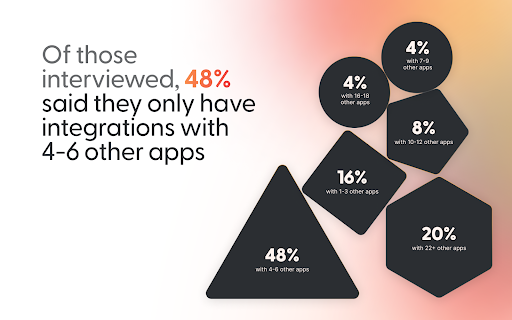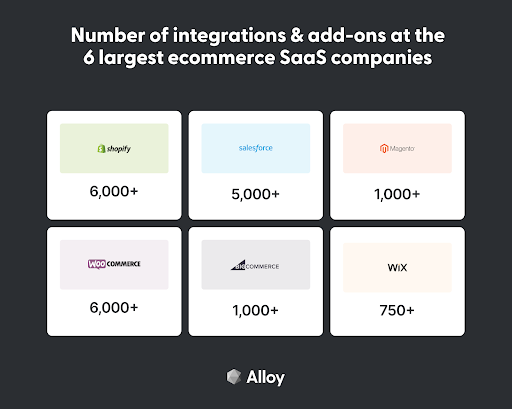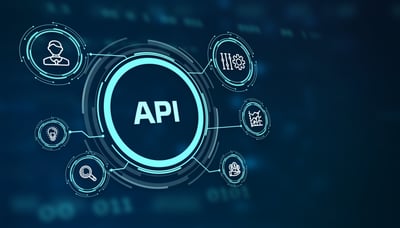April 28, 2023
 by Sara Du / April 28, 2023
by Sara Du / April 28, 2023

The future of SaaS lies in embedded ecosystems.
As highly specialized tools and applications grow, companies must consider the tools their customers work with and build a solution that seamlessly plugs into the different tech stacks.
Embedded iPaaS is one such well-integrated tech critical for scaling and long-term success in SaaS. Those who achieve smooth integrations and tap into the power of this ecosystem will emerge as their industry's frontrunners. Let's find out how.
Fifity-eight percent of partnership managers at e-commerce software companies need more than 22 integrations to have a successful marketplace. Forty-eight percent say they need at least 7-21 integrations.
However, 48% of the founders at the same companies mention only integrating with four to six other apps. This means almost half of them integrate with fewer apps than what partnership managers deem as a successful marketplace for e-commerce brands.

Source: Alloy Automation
Keep in mind, some of the largest e-commerce platforms also have the largest integration marketplaces available to merchants.

Source: Alloy Automation
Yet, on average, merchants use around six apps. So why expand your integrations when merchants use fewer than 10 apps?
The e-commerce ecosystem is quickly becoming unmanageable for merchants. Emerging tech companies must proactively help customers simplify processes by integrating with the tools they expect to use in their tech stack.
Merchants want to know how your product fits into their plans. By integrating with relevant apps, you solve customers' core problems and make it easier for them to manage and grow their businesses. Without an expansive integration marketplace, you risk losing customers to a competitor prioritizing integrations.
But building these integrations shouldn’t come at the cost of core product development or your engineers’ sanity. There are ways to make the process smoother and simpler for everyone involved.
Embedded iPaaS helps different applications and systems communicate without writing complicated code. With a comprehensive suite of integration and automation tools, SaaS teams can quickly launch integrations with just a few lines of code.
An embedded iPaaS, or embedded integration platform as a service (iPaaS), is a low-code, cloud-based platform that enables product teams to quickly and easily connect applications, data sources, and services. It makes the integration process faster, simpler, and cost-effective.
And the following features make these benefits possible (make sure you use a tool that offers these at the bare minimum).
Tip: Remember, an embedded iPaaS differs from a basic iPaaS platform. On the surface, it's a small difference in terminology – but the use cases and capabilities vary significantly. If you want to extend integrations, then an embedded iPaaS is what you need.
You’ve likely heard of automation and iPaaS platforms before. These tools benefit more advanced end users who want to connect their tech stack and build workflows to tackle repetitive back-office tasks (like sending a message when your inventory count is low).
You may think, why can’t I just build a connector with an automation platform and let my customers integrate their tools that way?
Here are a few reasons why:
Integrations are table stakes for SaaS companies, but you do not need to outsource at the expense of your user experience.
Embedded iPaaS allows independent software vendors (ISV) to incorporate the integration into their app's interface, so there's no extra effort required from the end user. The ISV already configures integration workflows and custom fields, so end-users only need to authenticate access. This allows customers to connect in a matter of clicks versus setting up complicated workflows on their own in hours.
In some cases, it makes sense to integrate a connector into an iPaaS and let your customers automate their data sync manually. It can be a unique use case that would benefit specific customers. Or, maybe the integration you need to build is more complicated, so to give yourself time, your customers use an iPaaS with basic functionality while they wait for you to launch the integration.
However, an embedded iPaaS can achieve everything an automation platform can for your customers, plus more.
Embedded links (integrations you share externally through a link) allow you to create workflows only shared with a specific group of customers (a perfect option for end-users with unique use cases). Plus, even the heartiest integrations can launch in weeks since the embedded iPaaS does the heavy lifting.
Here's a quick side-by-side comparison to understand why building a connector isn’t the best approach for you or your customers.
Here’s why an embedded iPaaS is the best option to offload your integrations.
|
Feature |
Embedded iPaaS |
Basic iPaaS |
|
API endpoints |
More customizability around endpoint access and field mapping. |
Only what’s been scoped on the automation platform. |
|
Time to create and launch |
If you’re using an embedded iPaaS, it takes about two weeks. |
It depends on your customer and how much time they have to build workflows. |
|
Upsell opportunities |
Building integrations allow you to upsell certain features, especially for complicated integrations with gate access. |
None. |
|
User experience for customers |
Easy user experience. Customers can integrate immediately after authentication. It offers more customizability since you can choose which fields you make configurable. |
Poor user experience. The onus is on your customer to build and maintain the workflow. |
|
Cost to customer |
No cost for your customer unless you offer the integration as an upsell. |
The cost is to your customer, which ranges depending on the tool they use. Some customers may hire a freelancer to build their workflows, adding to the cost. |
|
Credibility through guidance |
You’re an expert on the software you’re selling. You know who your platform should integrate with and how. This guidance means you think of customers on how to leverage your tools with others. |
Automation means putting the work into your customer’s hands. This can be good if customers have a unique and complicated use case that only benefits them. You should build and offer integration for common data syncs to all customers. |
Expanding your integration marketplace with embedded iPaaS is easy. Consider the following when offloading SaaS integrations to embedded iPaaS.
When considering integration costs, look at the set-up, maintenance, and potential team costs.
Every platform differs, but for embedded iPaaS, expect a platform fee and a cost per integration based on complexity, volume, or usage. Some platform costs are typical, but the integration costs can vary.
You don’t have to worry about maintenance fees with an embedded integration platform. Maintenance is included in the upfront cost.
Consider the following when it comes to infrastructure.
Here are some questions to ask to understand if you should build or buy integrations.
When building integrations in-house, 36% of product managers take less than three months to go from scoping to go-to-market with the integration, and 42% take longer than three months.
Essentially, you need to understand if you have the bandwidth to refocus your team from your core product, if revenue and growth are a top priority and if the integration use cases are time-sensitive.
SaaS companies can thrive through a highly connected tech stack by providing sophisticated and tailored solutions. These solutions address unique barriers merchants face and grant access to vital data and functionality within the ecosystem.
You just have to decide how to get your company to that level.
Businesses need to stay ahead of the game and prepare for future growth and success. Building out your integrations with an embedded iPaaS will give you the agility to keep up with changing trends in the software landscape.
With a reliable integration platform, you no longer need to worry about building your integrations or outsourcing them to an agency – the technology is already there, making the entire process easier.
There's never been a better time to get ahead of a trend.
Finished developing your integrations and now want to connect your data? Learn more about data integration and how it combines data residing in disparate systems to provide unified access.
Sara Du is the Co-Founder and CEO of Alloy, a white-labeled integrations platform for SaaS companies and brands to reduce engineering work and increase the speed with which they ship integrations. We’re building the missing connectivity layer for e-commerce by integrating with hundreds of apps so you don’t have to.
Tired of the complex and endless cycle of integrations and reintegrations? Are they standing...
 by Daniel Twigg
by Daniel Twigg
If you work at a SaaS company, you know how essential integrations are to your customers.
 by Beth Harwood
by Beth Harwood
As organizations look to differentiate their product in a crowded market, they have a variety...
 by Jon Gitlin
by Jon Gitlin
Tired of the complex and endless cycle of integrations and reintegrations? Are they standing...
 by Daniel Twigg
by Daniel Twigg
If you work at a SaaS company, you know how essential integrations are to your customers.
 by Beth Harwood
by Beth Harwood


